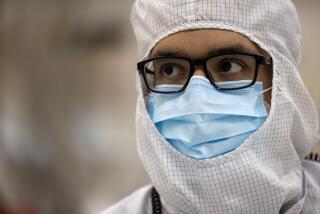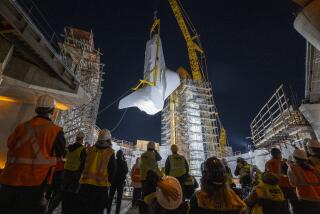NASA prepares Hubble’s final upgrade mission
GREENBELT, MD. — This month, 24,000 pounds of what may be the most thoroughly tested and closely inspected hardware on Earth is being delivered to Cape Canaveral, Fla.
After it arrives, the one-of-a kind camera and spectrograph, which has been stored at the Goddard Space Flight Center, will be inspected once more, loaded onto the space shuttle Atlantis and launched into orbit 350 miles above Earth.
There, astronauts will rendezvous with the Hubble Space Telescope for a long-delayed 11-day servicing mission.
The $900-million effort, scheduled for launch Oct. 8, will be the fifth and last Hubble servicing mission, and engineers and scientists on the ground in Maryland have great hopes for the upgrade to one of the world’s best-known scientific instruments.
“I think it will put Hubble at the apex of its capabilities,” said David Leckrone, senior project scientist for the Hubble. Leckrone and other NASA scientists geared up for the launch at NASA Goddard, which manages Hubble’s day-to-day operations. Scientific operations are based at the Space Telescope Science Institute on the John Hopkins University campus in Baltimore.
Scientists at Goddard tested sensitive scientific equipment in an acoustic chamber to make sure that what goes into space can withstand the violent shaking that characterizes every shuttle launch and the eight-minute ride into orbit.
Engineers tested containers with weights and cranes to make sure they won’t fall apart under stress and reviewed a wide range of contingency plans for scaling back the spacewalks and repairs to Hubble if there are equipment failures.
“We’ve been getting ready for this since August of last year, trying to think up every possible scenario,” said Keith Walyus, Hubble mission operations manager.
In a series of five spacewalks, astronauts will give the Hubble a new set of gyroscopes to stabilize the telescope. They’ll also install a thermal blanket to protect internal workings from the extreme temperatures of space and a new set of batteries to extend its life span to 2013.
Astronauts also will repair the Space Telescope Imaging Spectrograph and the Advanced Camera for Surveys, a scientific mainstay that has produced many of the striking images that adorn science classrooms and computer screens around the world.
Astronauts will also install a new wide-field camera to study dark energy, and a cosmic origins spectrograph that will examine the large-scale structure of the universe.
Left on its own, the telescope would probably only last another couple of years, said Preston Burch, Hubble’s program manager. “Without the mission, it’s hard to really say what the future of Hubble would be,” he said.
Up to 8,800 scientists have used the archive of data Hubble has produced, and astronomers worldwide have written 7,724 scientific papers based on Hubble findings since its launch in 1990. The telescope is still responsible for about 12 discoveries a week, Leckrone said.
“It’s simply the most productive telescope in history,” said Matt Mountain, director of the Space Telescope Science Institute, which oversees Hubble’s scientific operations.
Together, the improvements should give Hubble unprecedented capabilities to shed light on how galaxies form, how stars are born and die, the mysteries of dark matter and dark energy, and the architecture of the universe itself, NASA says.
More to Read
Sign up for Essential California
The most important California stories and recommendations in your inbox every morning.
You may occasionally receive promotional content from the Los Angeles Times.










